It's mid-October 2011 and we've got some time off. We're all great fans of Frederick II, the Hohenstaufen Holy Roman Emperor and King of Sicily, so now's our chance.
You may not find this terribly rewarding unless you're included here, so this is a good time for casual and random browsers to turn back before they get too caught up in the sweep and majesty of the proceedings and can't let go.
We're back from the Boot of Italy and joining up with Kristin's mom and Fr Richard for some days of general sightseeing.

And a few days of general lèche-vitrines, as well.
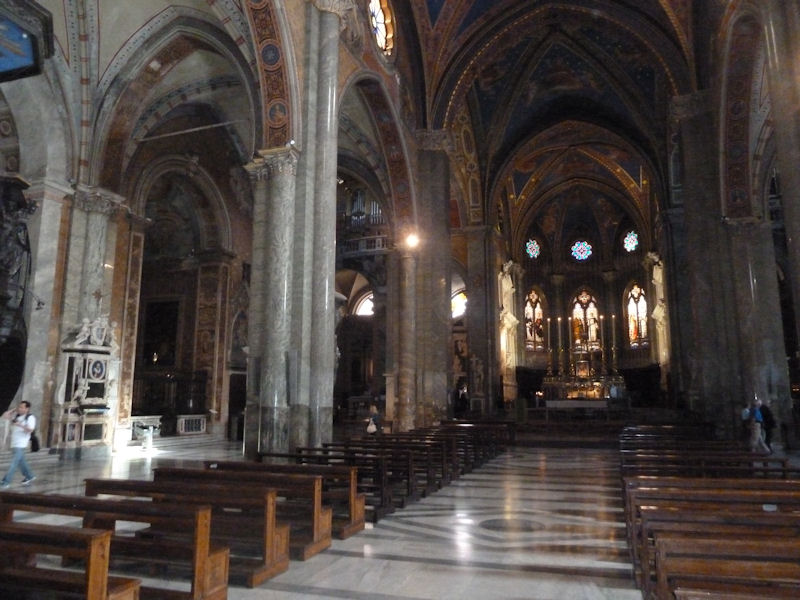
A quick church-stop to get things moving along

Kristin and the Piazza della Rotonda, home of the Roman Pantheon, commandeered by the Christians to become just another "St Mary and the Martyrs" church
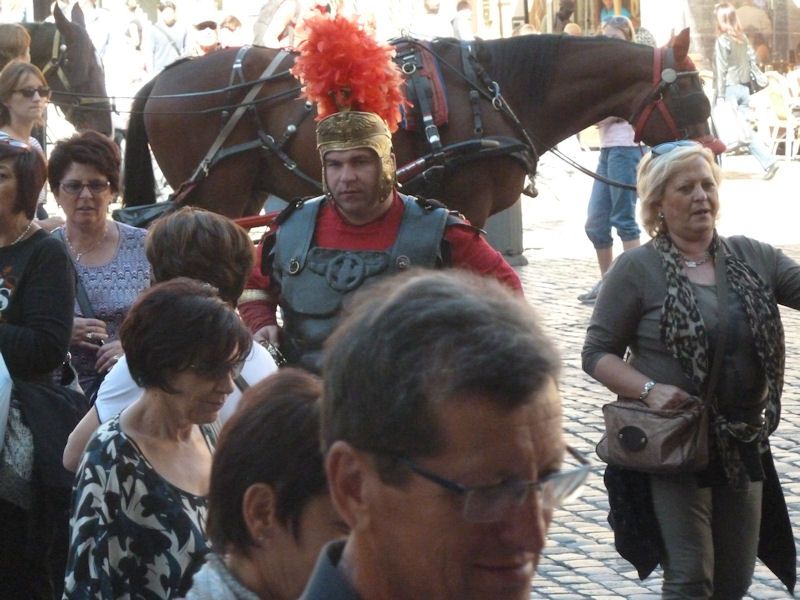
A Roman centurion relaxing despondently amongst the tourists. In the economic downturn, so many semi-photographable Romans in plastic gear were turning up around the Colisseum and jostling for the tourist trade that fights were breaking out, so the authorities have tried to disperse them round the city.

In the Pantheon: lots of dead notables are walled up in here, too, like one of our favorite composers, Corelli, young Raphael the Renaissance superstar, and the first king of all Italy, Vittorio Emanuele II, "Padre della Patria".
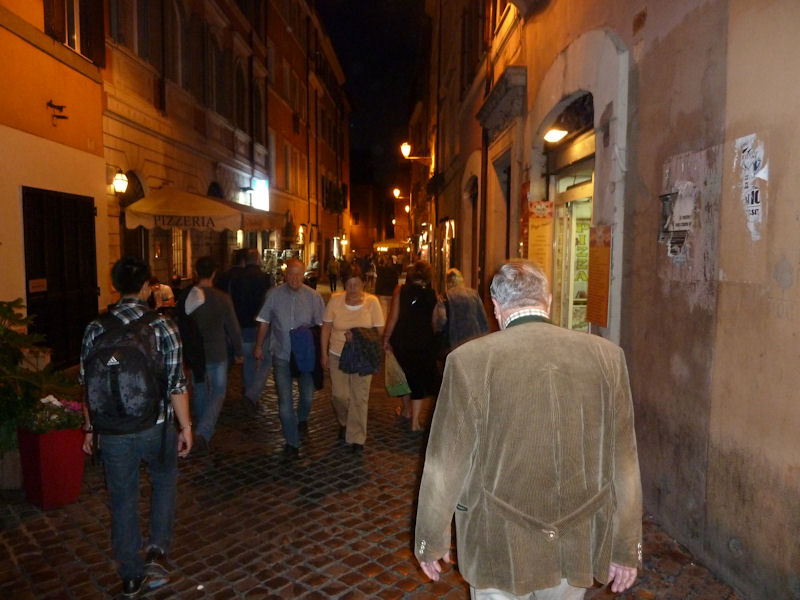
Time for dinner

We're staying up in Monteverdi Vecchio on the Janiculum hill in Trastevere, Kristin and I in an undistinguished room down the street, and Joellen and Richard right here in the "Villino Giovanna al Gianicolo B&B", a wonderful place managed by Giovanni and his daughter Laura Ranghi, extremely welcoming and commodious as well, and very reasonably priced.
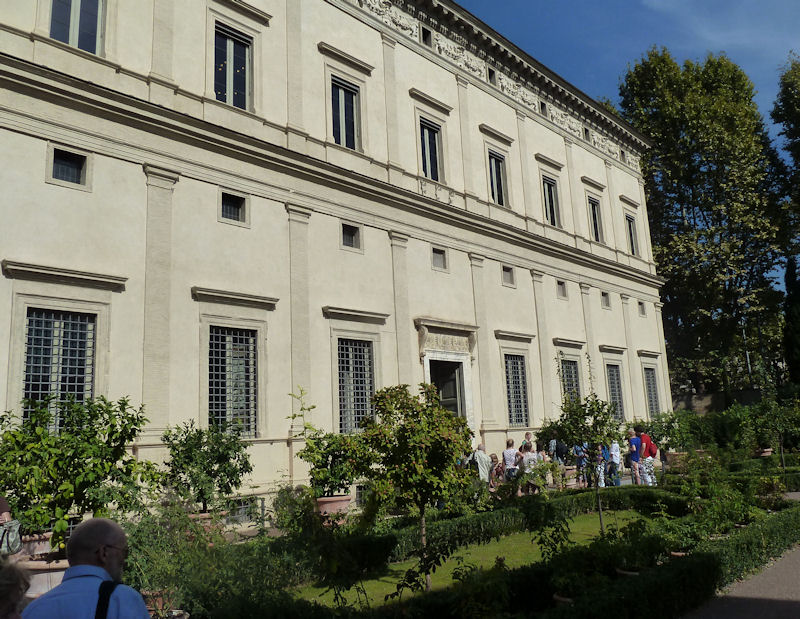
In the Villa Farnesina, built in the early 16th century for the proto-Wall Street Master of the Universe, Agostino Chigi, we're here to view one of the world's greatest collections of lewd and lurid frescoes.
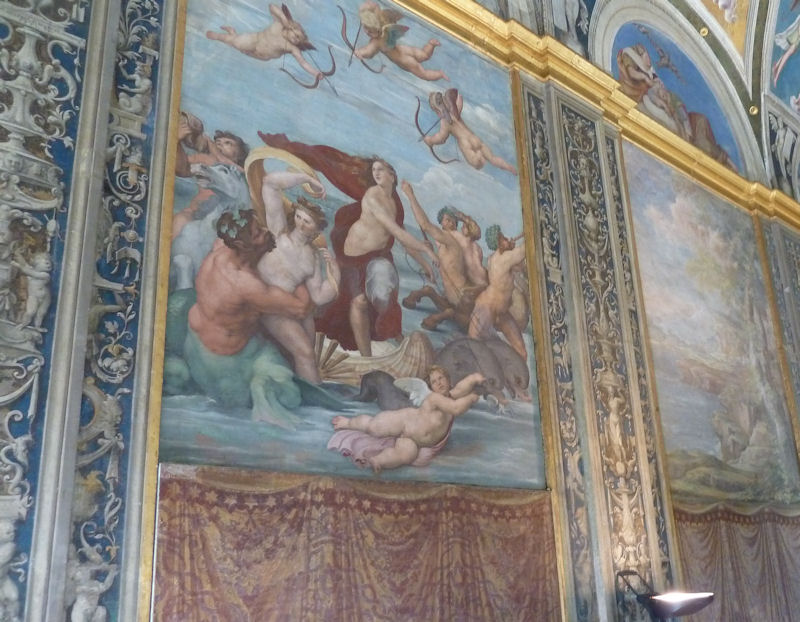
Like this one, oh, my goodness.

-- Ha ha. He's looking the other way!
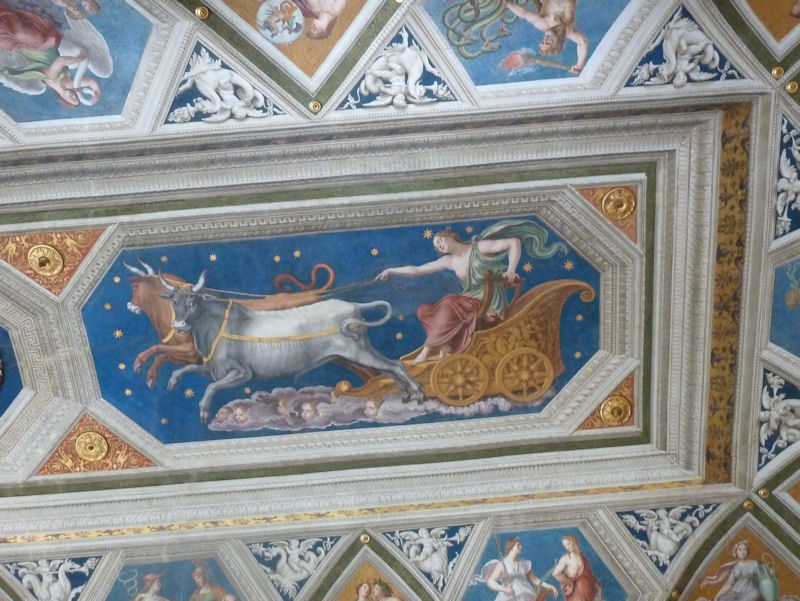
Early forms of bull transport

The Galatea Loggia in the Villa Farnesina (with art students following their instructors' directions)

One of several lively parties on the loggia's ceiling
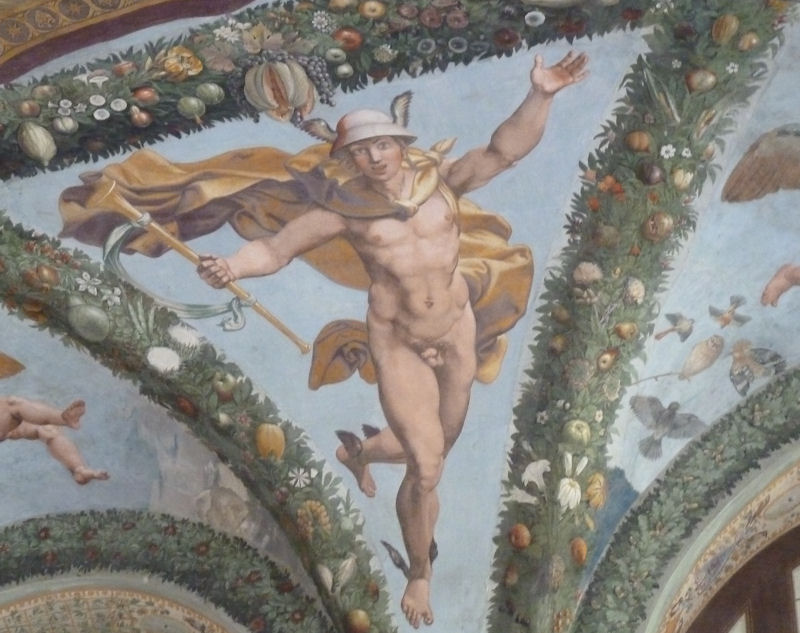
-- I'm all yours!
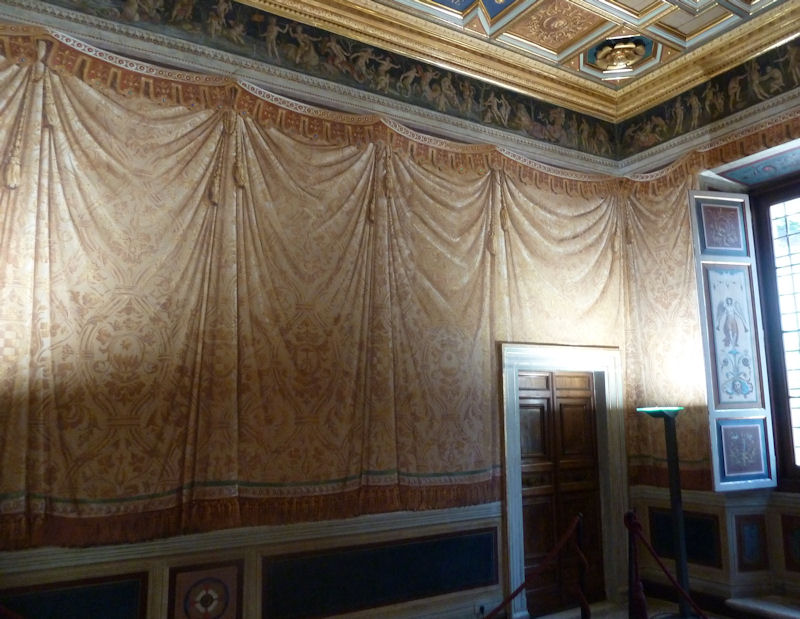
Lovely draperies in the Villa Farnesina. Nope. Trompe l'oeil. They're painted on the wall.
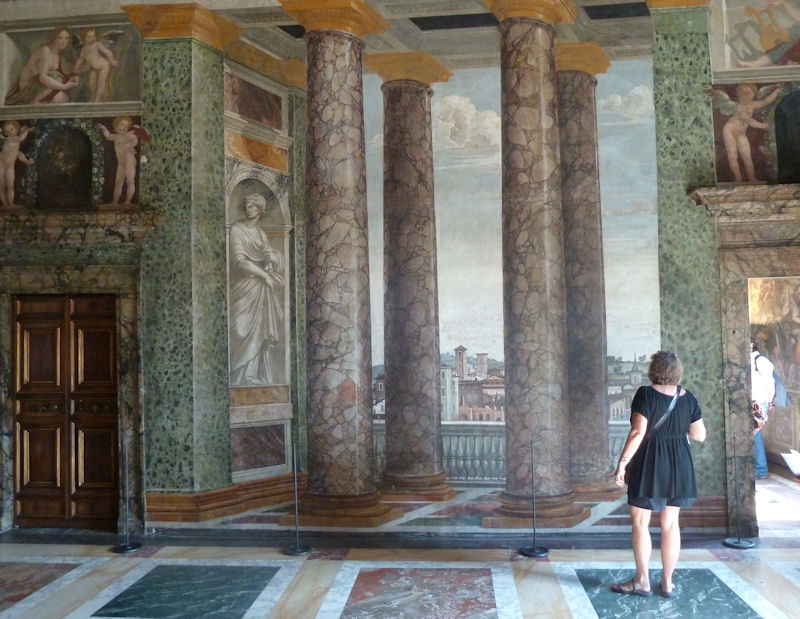
Kristin looking for the exit. Nope. Trompe l'oeil.
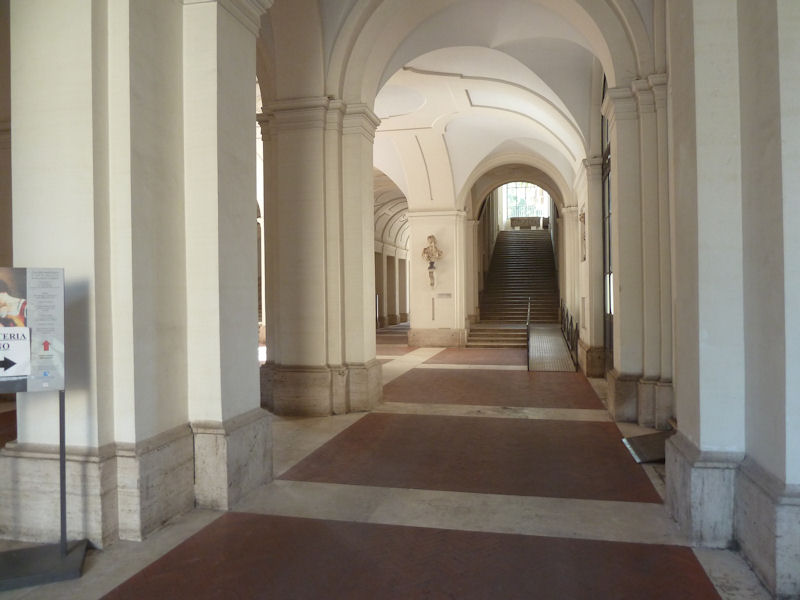
The Galleria Corsini across the street from the Farnesina
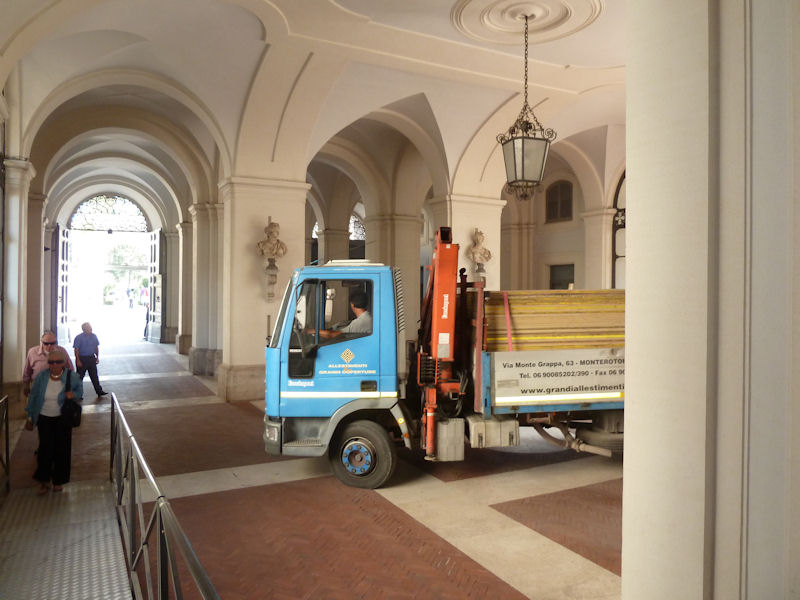
With big visitors
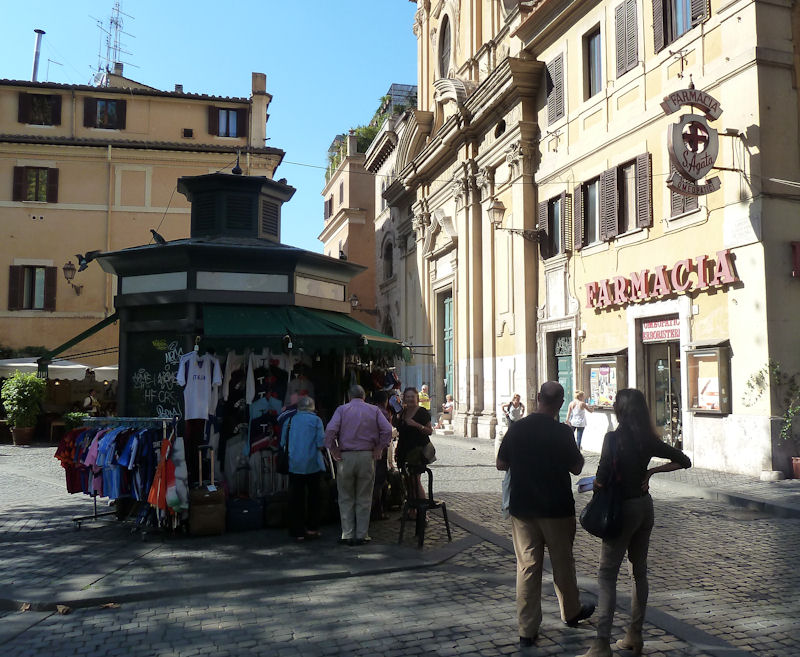
At the head of the street in Trastevere, we're buying newspapers, chocolates, souvenirs, and luggage for Dwight.
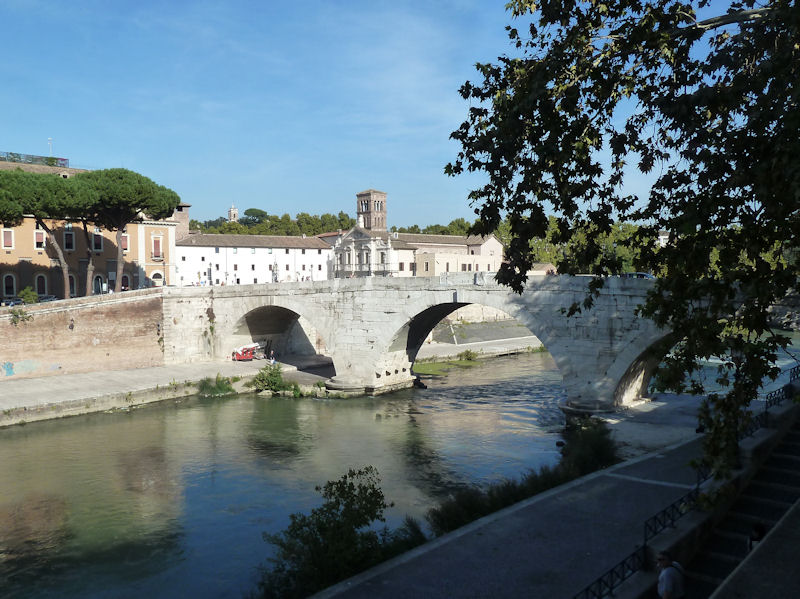
Bridge over the Tiber
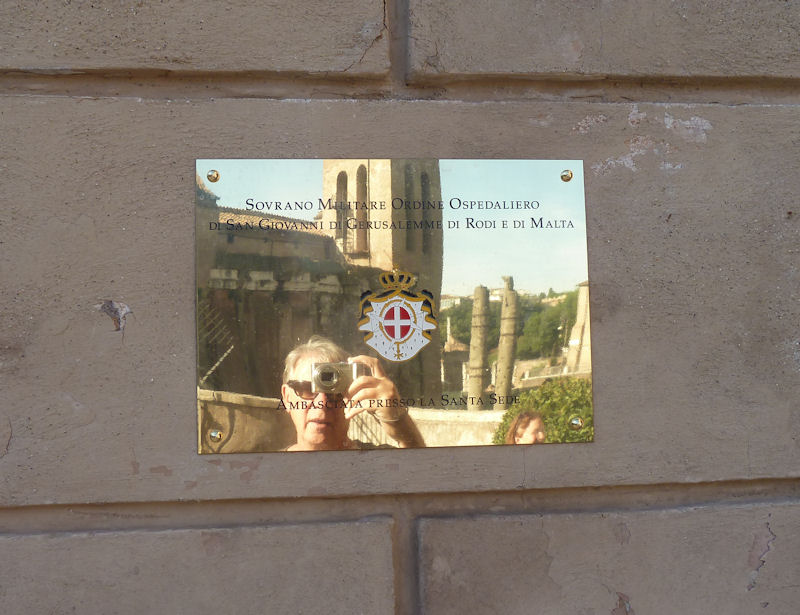
We've finally caught up with them -- the Sovereign Military Order of the Hospitallers of St John of Jerusalem, of Rhodes, and of Malta. This is their embassy (I suppose that that's the right word).

Kristin and the Theatre of Marcellus
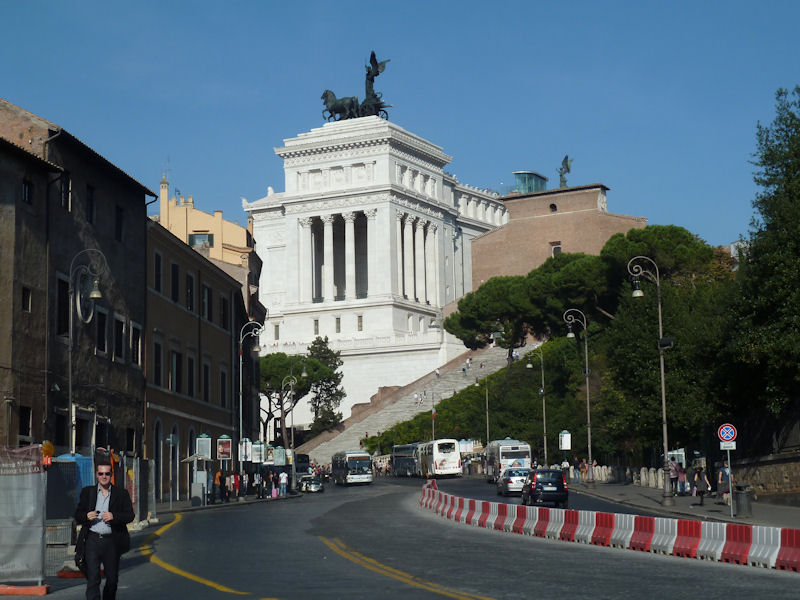
The off-side of 'The Typewriter', the monument to Vittore Emmanuel II
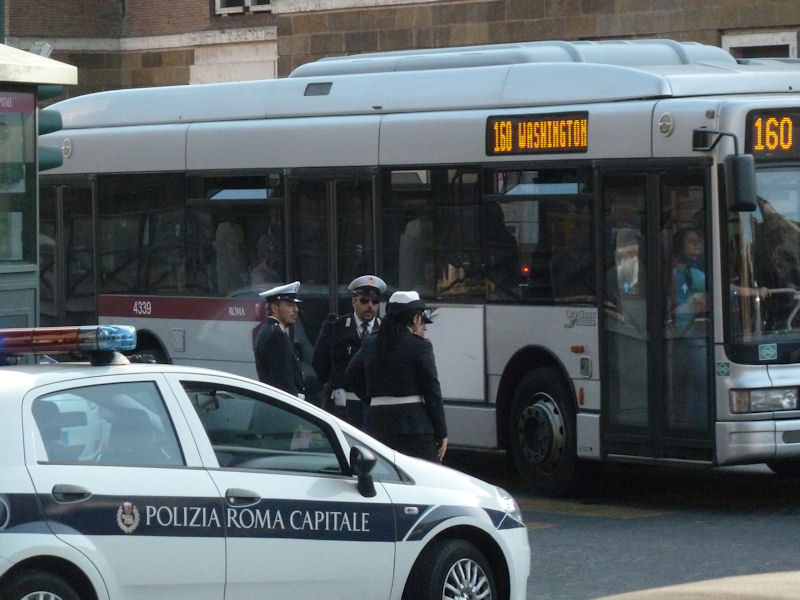
Police strategizing

The Palatine hill, where Rome was founded (so we're told)

A farm on the Palatine Hill

Palatine scenery
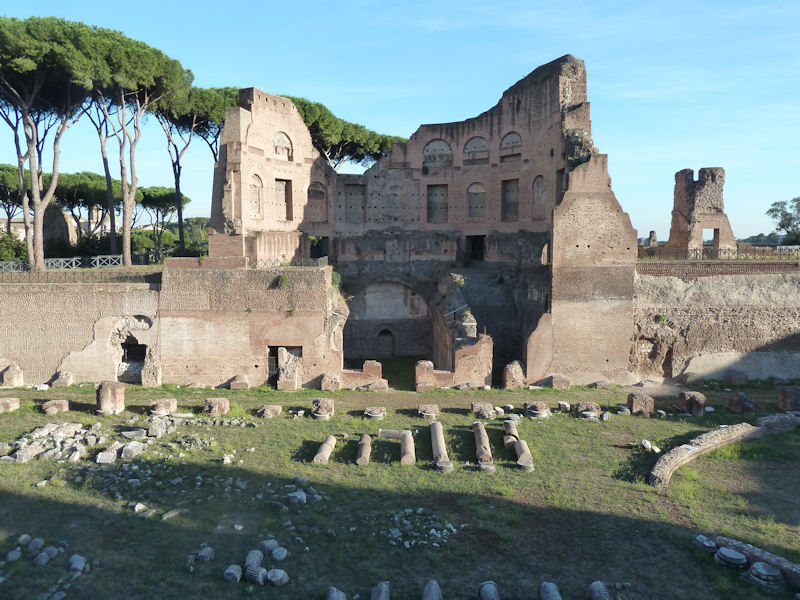
Ruins of the Augustan palaces
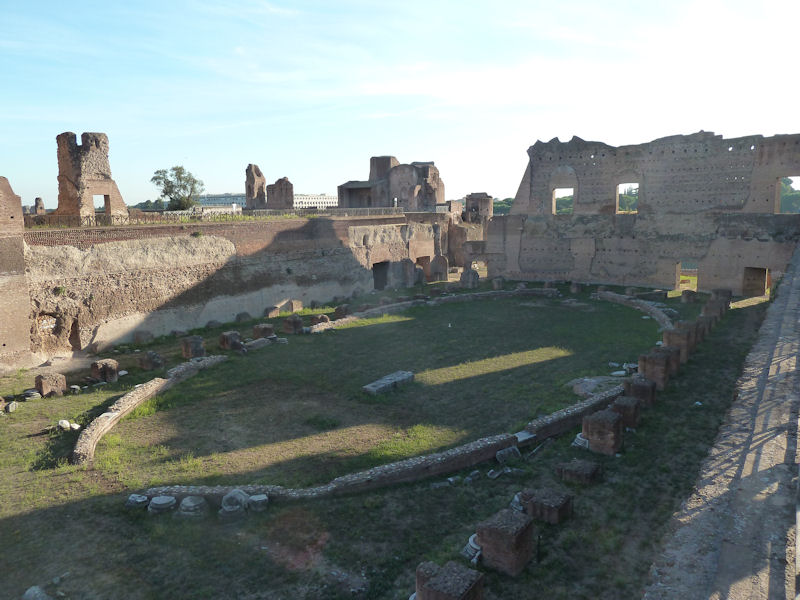
The stadium

Not exactly the Casa d'Augusto, the emperor's own house, but very near it.

So Caesar Augustus probably strolled casually right round here on long late-summer evenings. As we are.
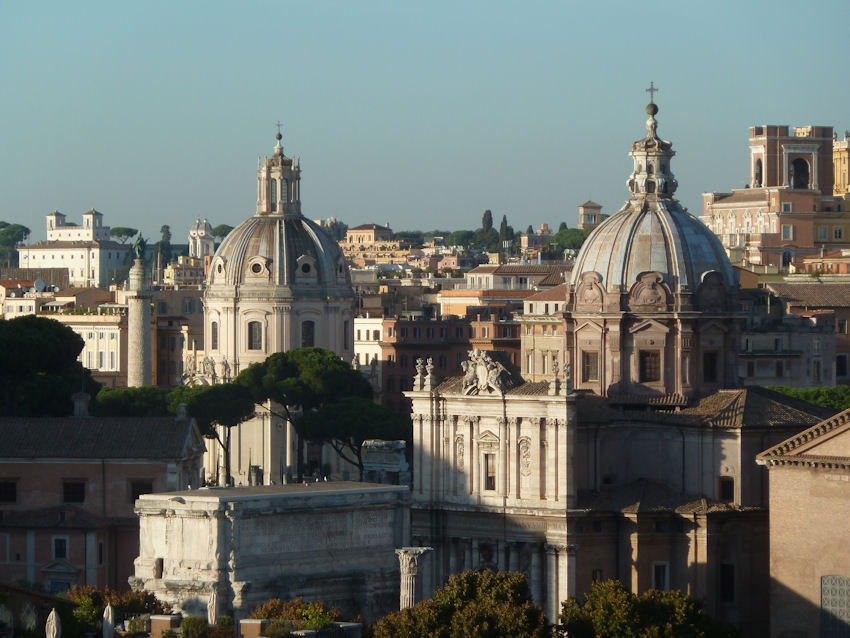
Downtown views from the Palatine Hill
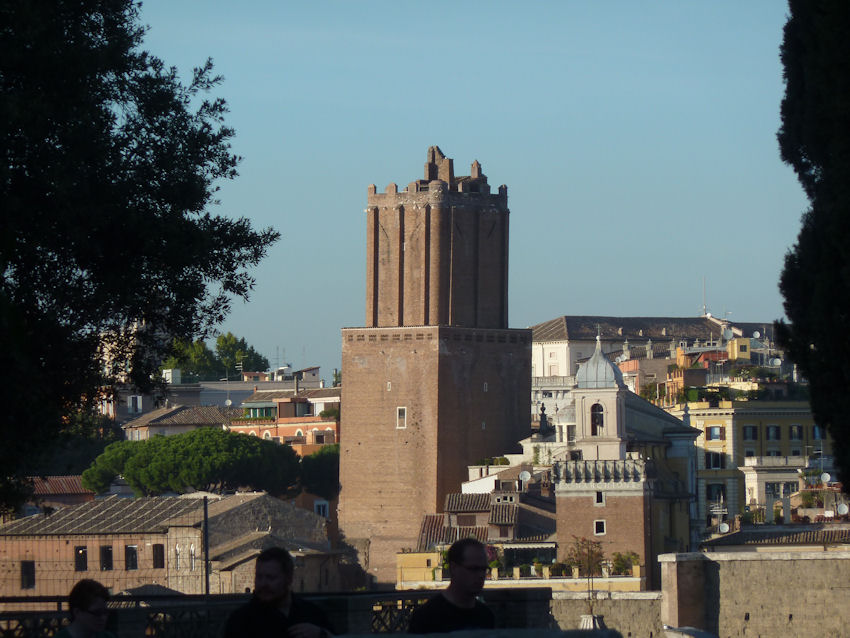
The weird Torre delle Milizie, Tower of the Militia, near Trajan's Market in the imperial fora, of uncertain origin but definitely passed back and forth amongst ruling Roman families at least since the Annibaldi family had it in the 1200s.
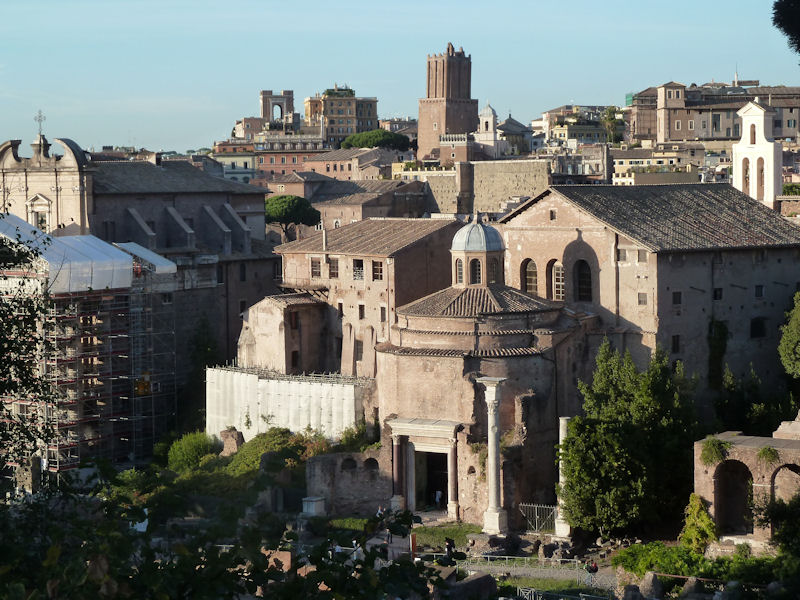
The Militia Tower dominating the neighborhood, as it was intended to do
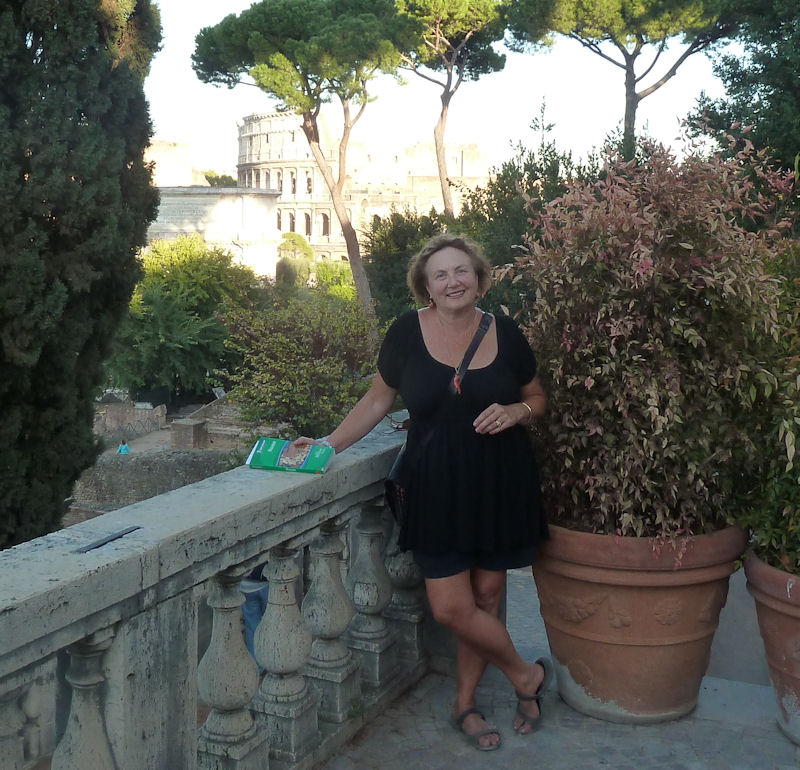
A pleasant smile in anticipation of a Roman dinner
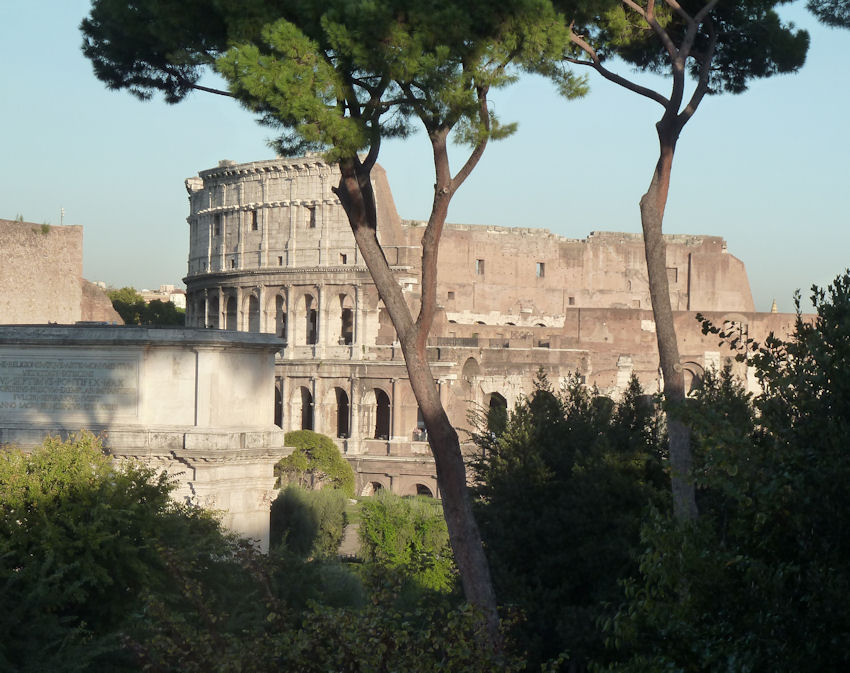
The Colosseum or what's left of it. This was originally the "Flavian amphitheatre" -- the "Colossus" was a very big statue of Nero moved alongside it early on, and the name transferred and got stuck.

A local fan of the Colosseum, who's never been in it but hopes one day to join the plastic-armored Roman soldiers patrolling the grounds of it.

From the Palatine
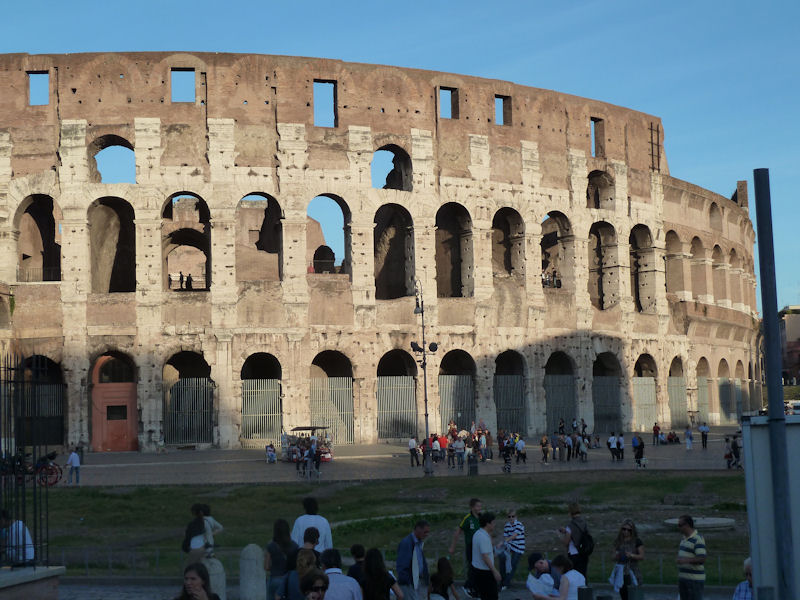
The Colosseum, most of the good stuff carted off centuries ago to build hovels for the undeserving poor. Everybody knows about the Great Fire of Rome in A.D. 64 (when Nero was allegedly fiddling), but there was another fire here in A.D. 192, when the Horrea Piperataria (the "Pepper Warehouse") next door, a depot for the Roman traders in the far east, which had become the safe deposit box for all the great merchants, went up in a week-long puff of smoke, ruined half the city's fortunes, and destroyed Galen's entire stock of medical books and medicines (History Today, Sept. 2011).
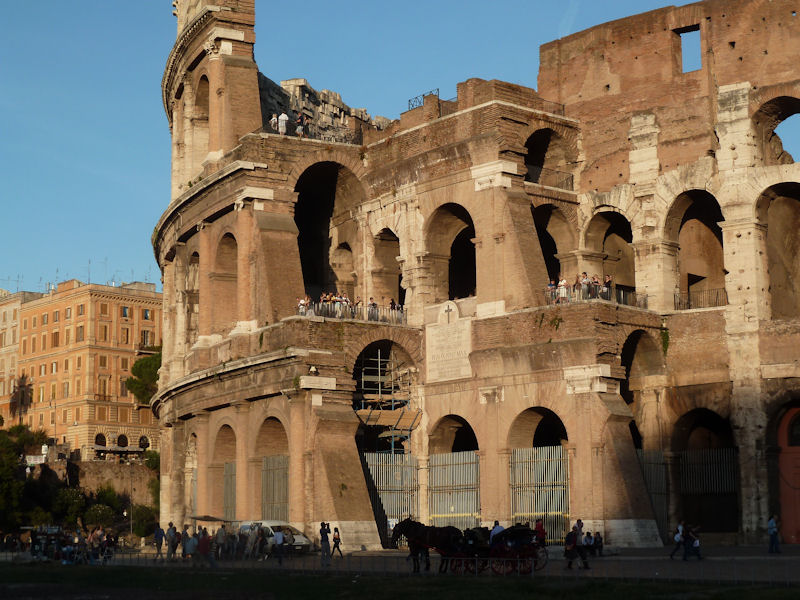
Enthusiastic crowds massed on the remaining balconies. A new project is intended to increase the areas accessible to the public by orders of magnitude, which may or may not be a good idea.
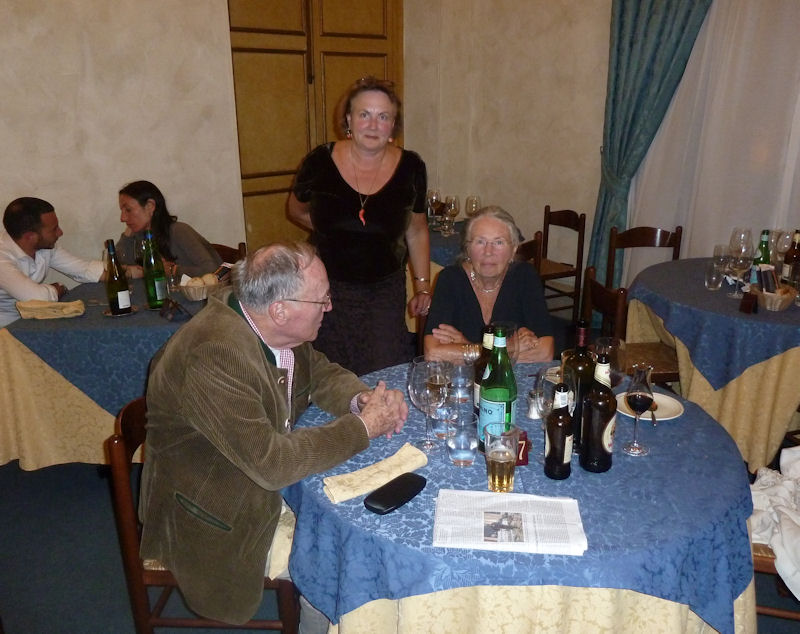
Dinner at the Eau Vive near the Pantheon and the Largo Argentina, where the waitresses, who are all third-world members of a religious order, try to get the diners to sing along to "Ave Maria". But the beer was good.
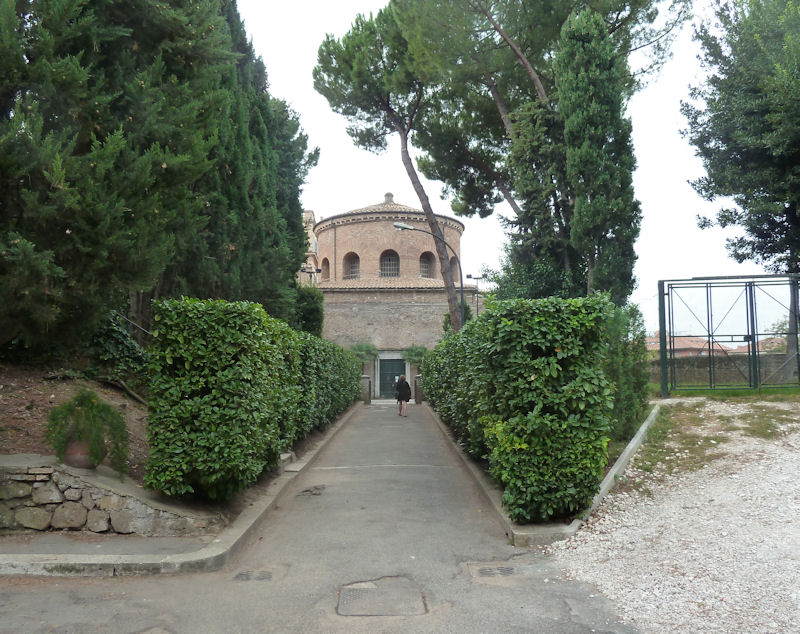
At the Mausoleum of Santa Constanza, the 4th century mausoleum for Emperor Constantine's daughters Constantia and Helena, pretty far out on the bus line next to the Basilica di Sant'Agnese (who has another gruesome martyrdom story!).
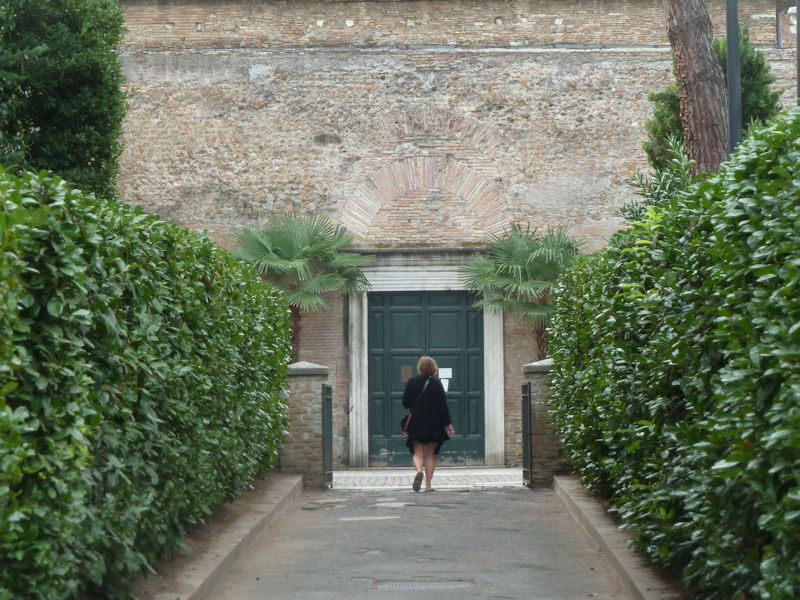
Kristin passing into the time warp machine

The ambulatory of the circular mausoleum, a millennium and a half after Constantia may have paced the same flagstones (though she herself got stolen for the Vatican's dead-people collection in 1790).
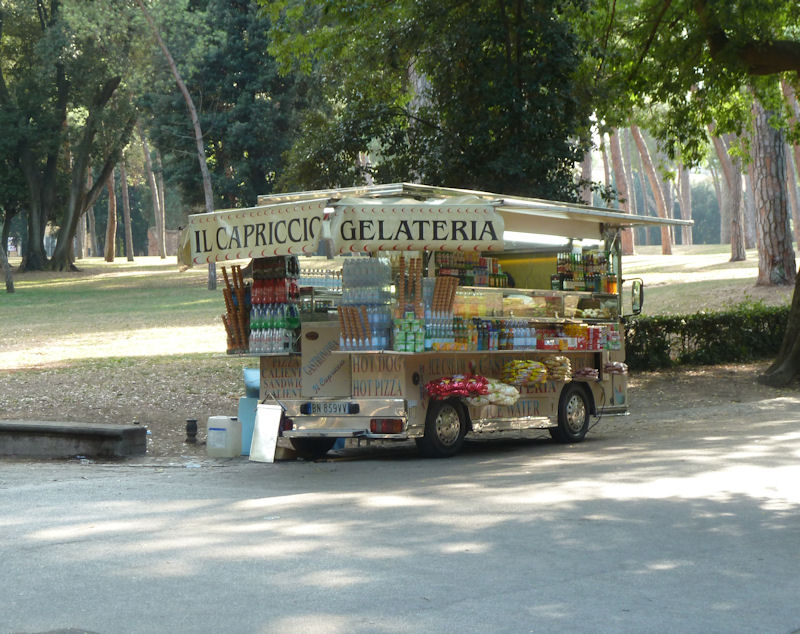
We've just come out of the Galleria Borghese (a two-hour walk-through wisely booked three weeks ahead), with its exquisite collections of stuff by Caravaggio, Raphael, Correggio, Titian, Bellini, Giorgioni, Veronese, Botticelli, Rubens and Cranach, amongst others, and best of all, my favorite sculptures of all time, Bernini's Apollo and Daphne, Aeneas and Anchises, and the Rape of Proserpina. No photographs were permitted, but here is the lovely snack wagon that greets one in the Villa Borghese park.
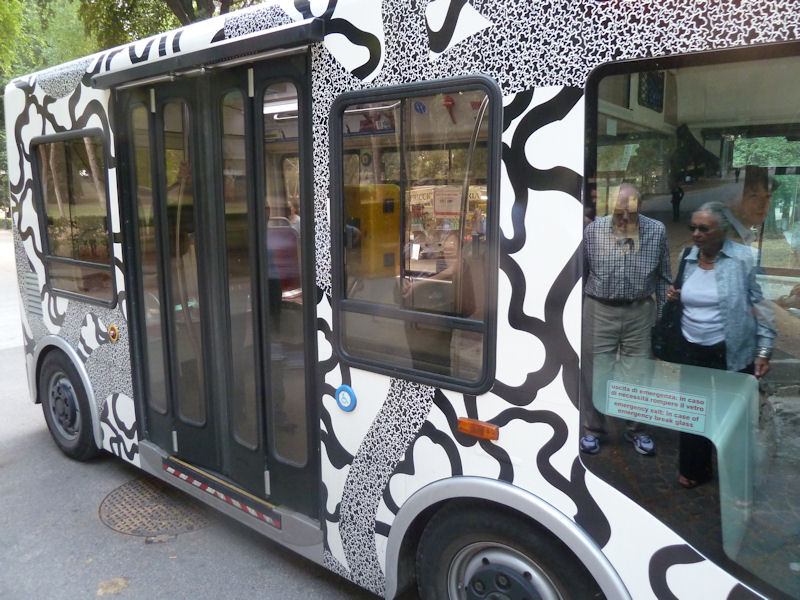
And here's the little shuttle bus that should take us back down into the city (but it didn't. It took us two blocks over to the end of the line and a 20-minute wait whilst the driver went off for a coffee. Or what the Italians like to call coffee.).
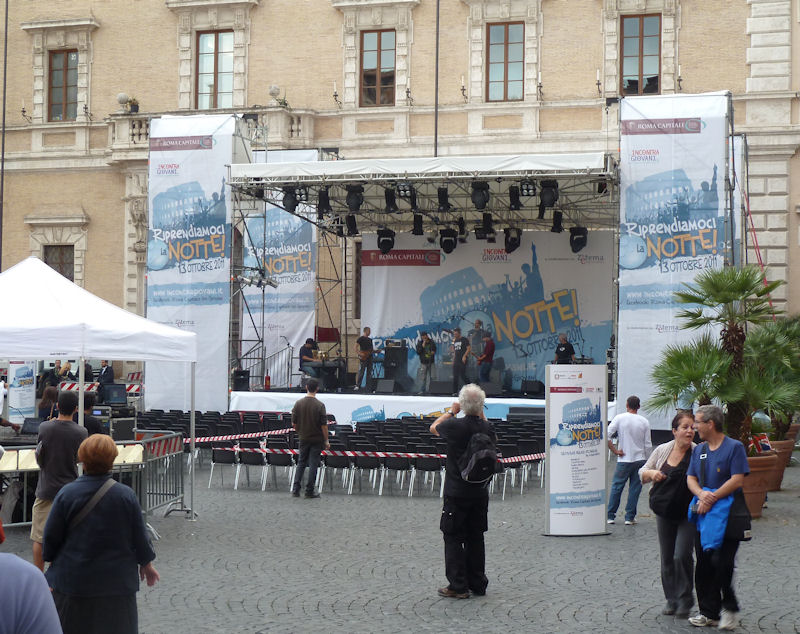
We're in the square of Santa Maria di Trastevere, for old times' sake, but with entertainment more up-to-date than what's on offer next door, the 12th-century mosaics in the church.
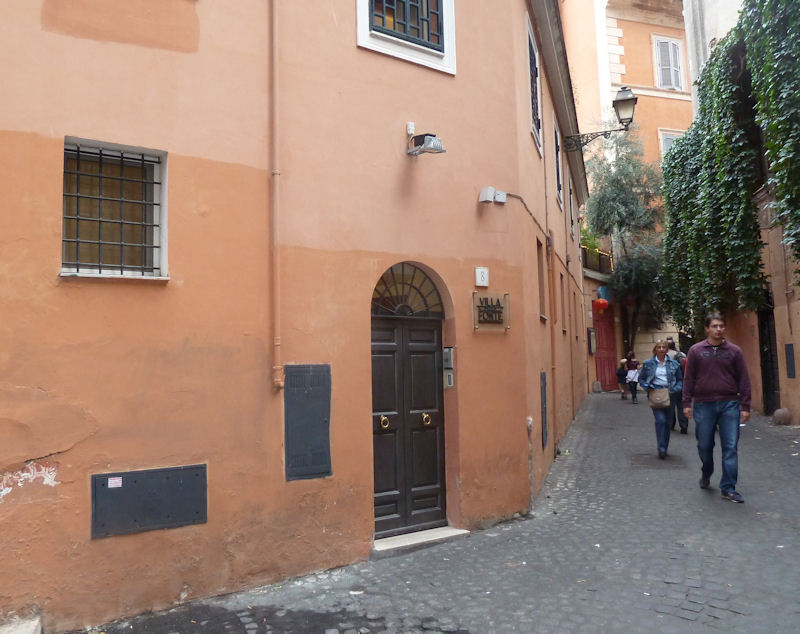
Just a block over, here's the front door of the Villa della Fonte hotel, in the Via della Fonte d'Olio -- a 17th century building with five rooms, in one of which we stayed a year or two ago when the front of it was utterly defaced by spraypainted nonsense graffiti.
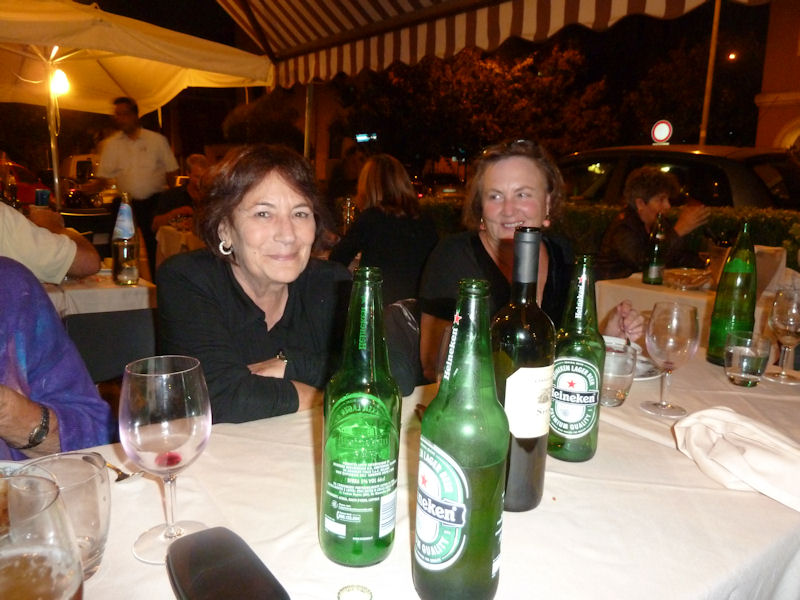
Dinner in Trastevere with friend Barbara. (No apologies for the Heineken, it was all they had.)

Street scene

Looking for just the right gift for those back home
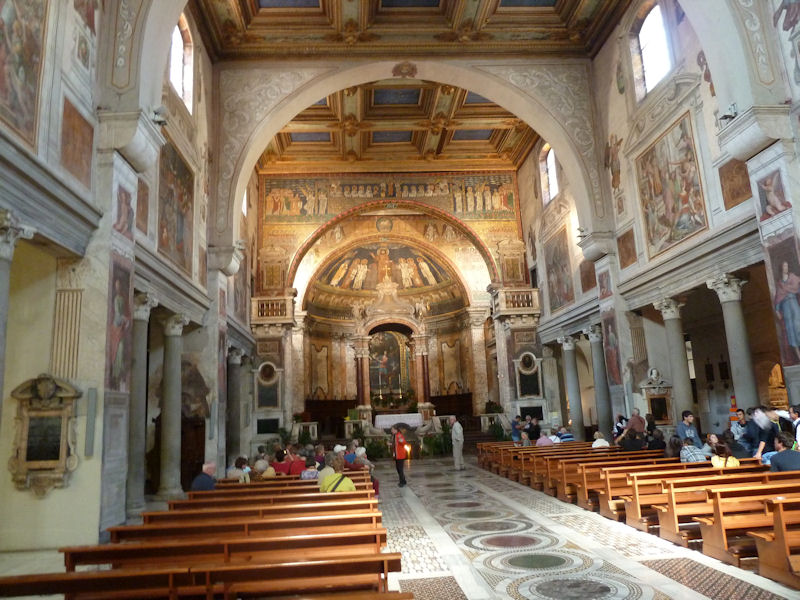
The church of Santa Prassede (one the two formerly sainted sisters [the other is Pudentiana] who lent Saint Paul a hand at an anxious moment in his life) (both of whom have churches here, but neither of whom has had a valid sainthood license since 1969), a 9th-century building with excellent Byzantine-style mosaics.
[This is actually a misunderstanding. No saint can be 'unsainted' or 'decanonized', evidently, but in 1969 the Roman church revised the General Roman Calendar of feast days, etc., and removed something like 300 saints, identified in several complicated categories, from the list of universally recommended feast days. Any saints can still be venerated by anyone who feels like it or by any locality or religious order that prefers to stay in touch. Some in the 1969 loser list were referred to as 'removed', others as removed from particular calendars, but the recommendation for both St Pudentiana (19 May) and St Praxedes (21 July) is that they be venerated in their own 'Titular basilica only'. So the B Team, in effect. (added in Dec. 2024)]
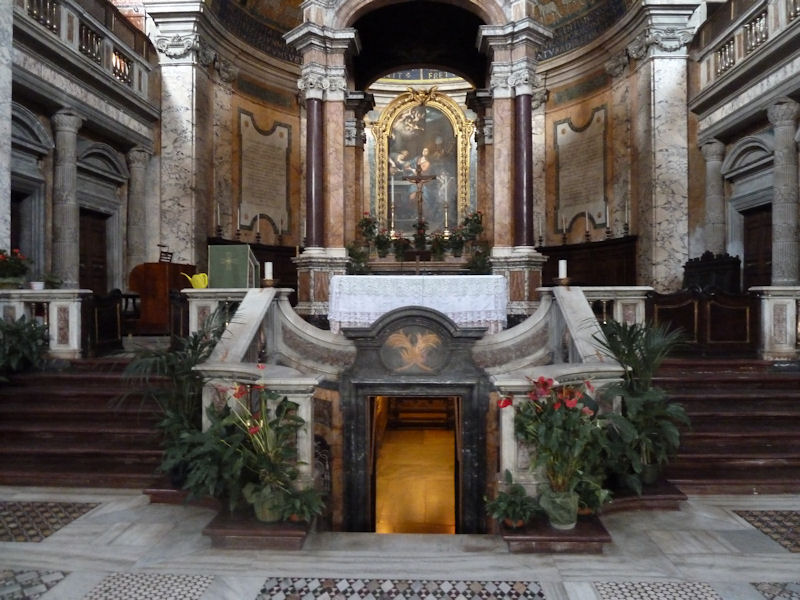
And with a walk-in crypt
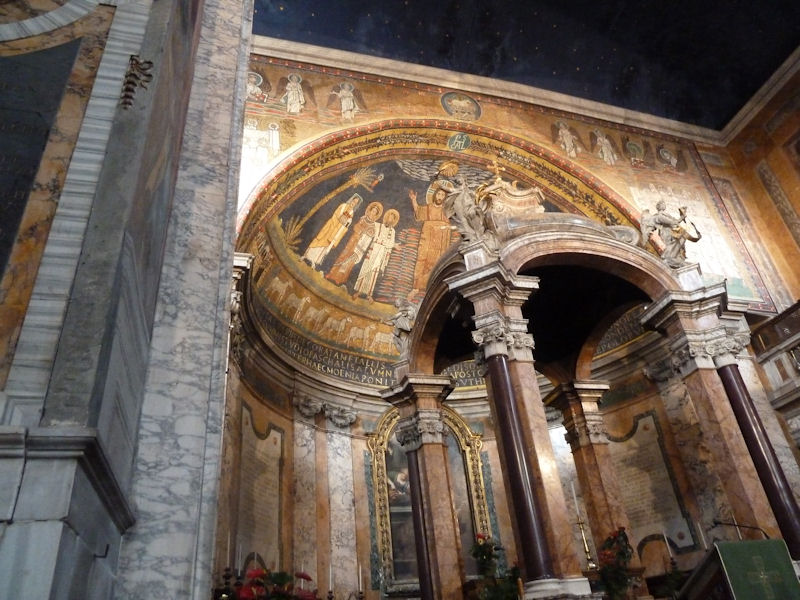
Byzantine-looking mosaic things
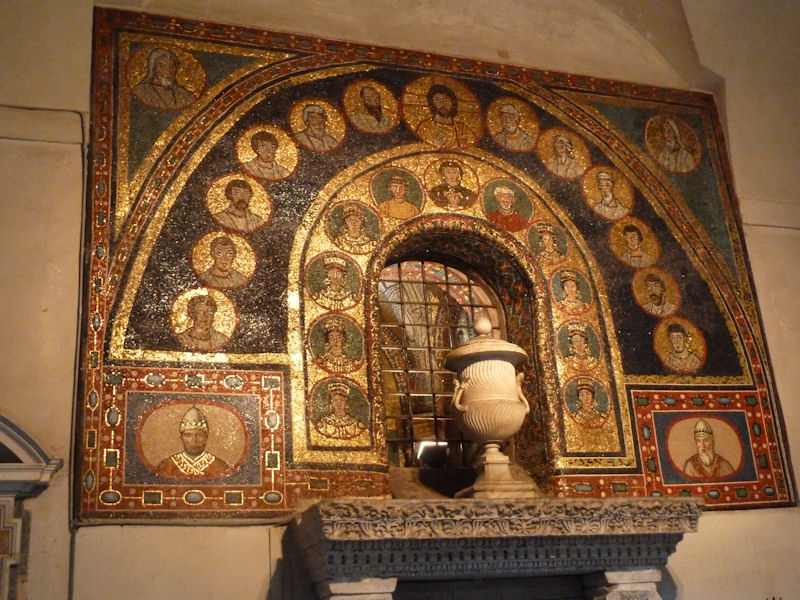
In the back room, the Cappella di San Zenone, the "treasures", and what may or may not be the remains of the artist Paschal's mother
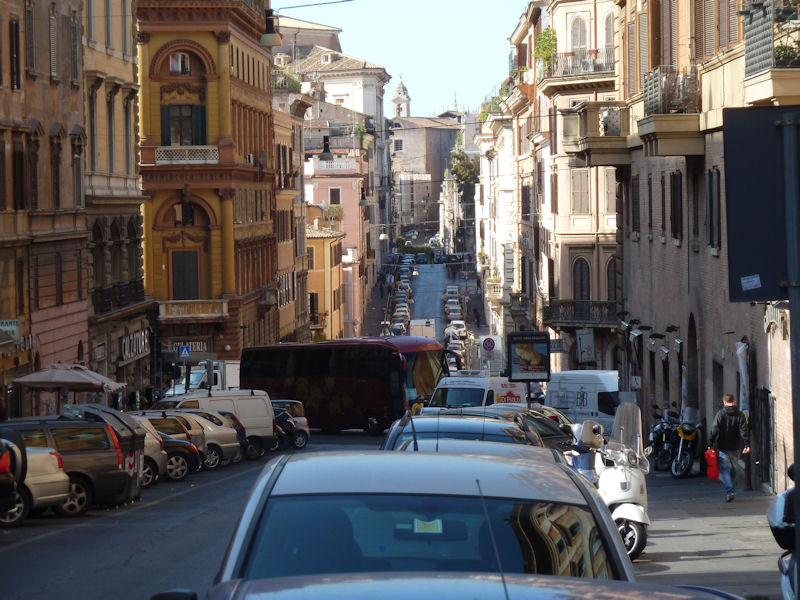
Roman street scene
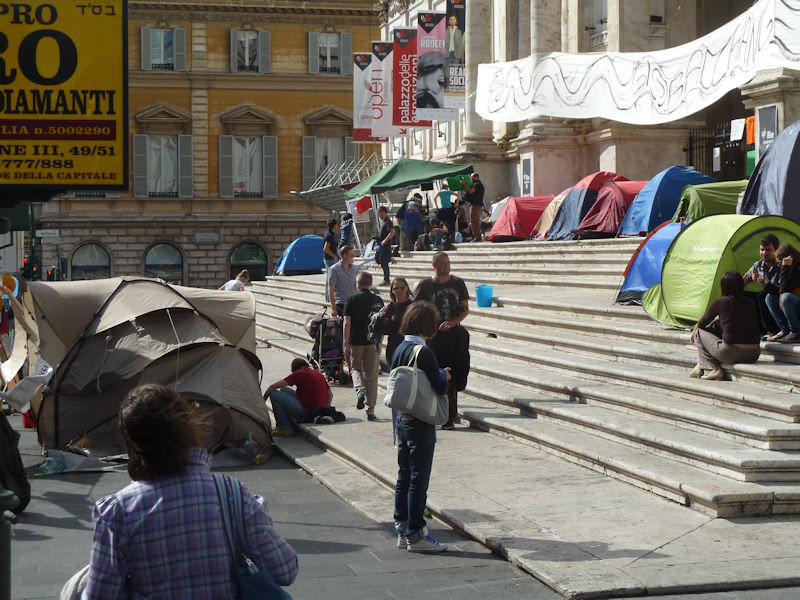
'Occupy Rome'!
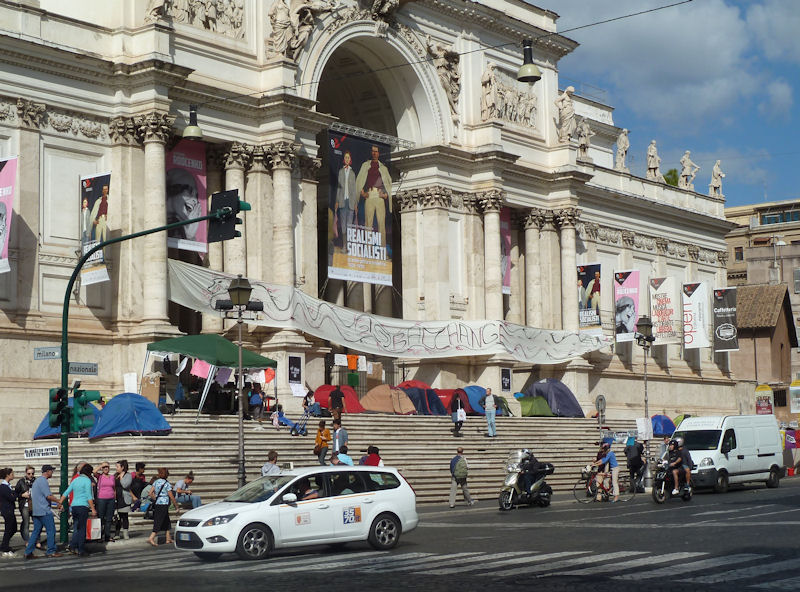
'Change you can believe in'
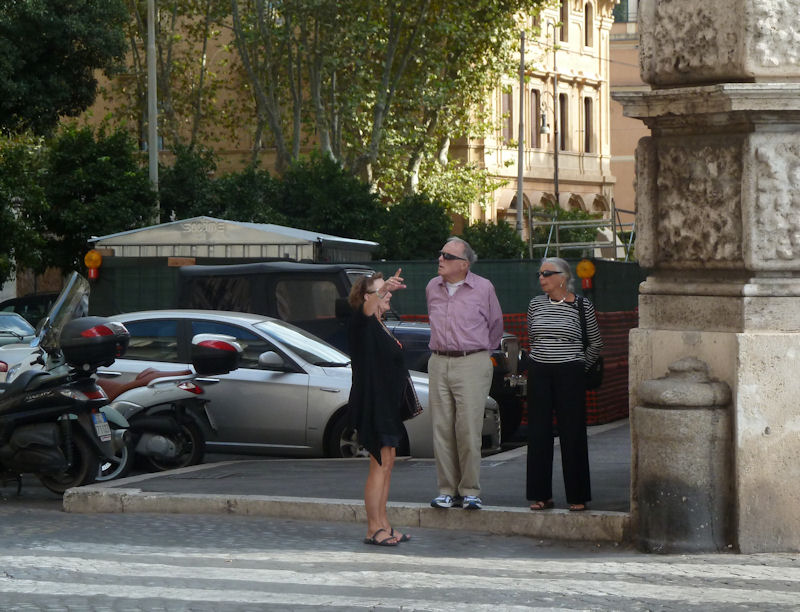
Kristin pointing out the most important sights
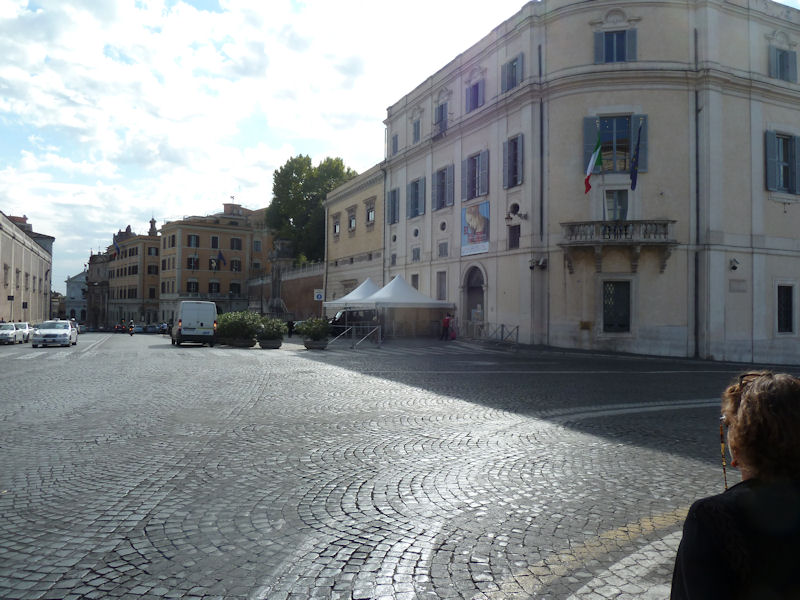
We're at the Scuderie del Quirinale for the exhibition of Filippino Lippi's work and influences. Very good. A little too religious, but good.
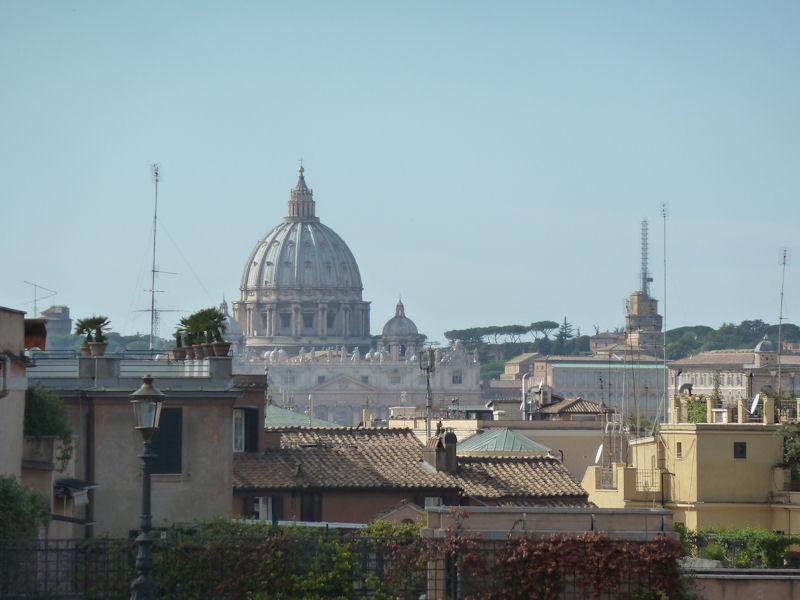
The view off the Piazza del Quirinale
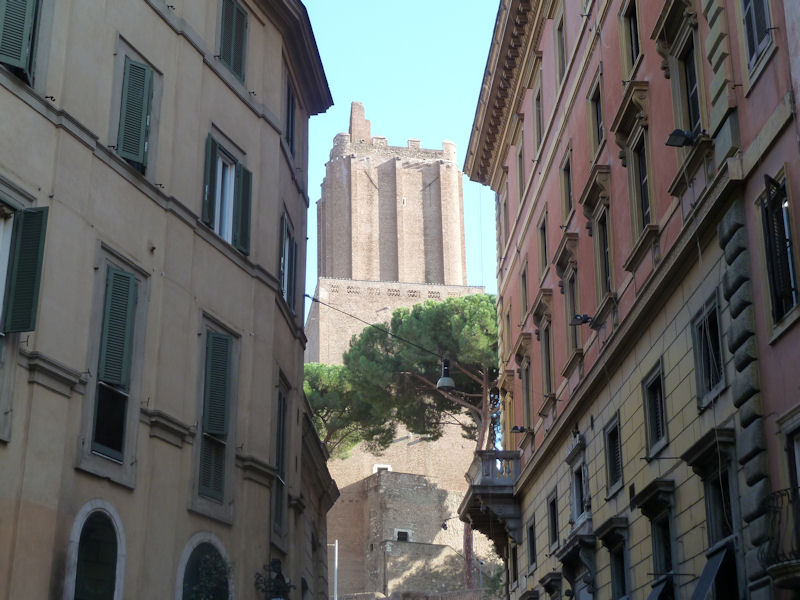
The Militia Tower again
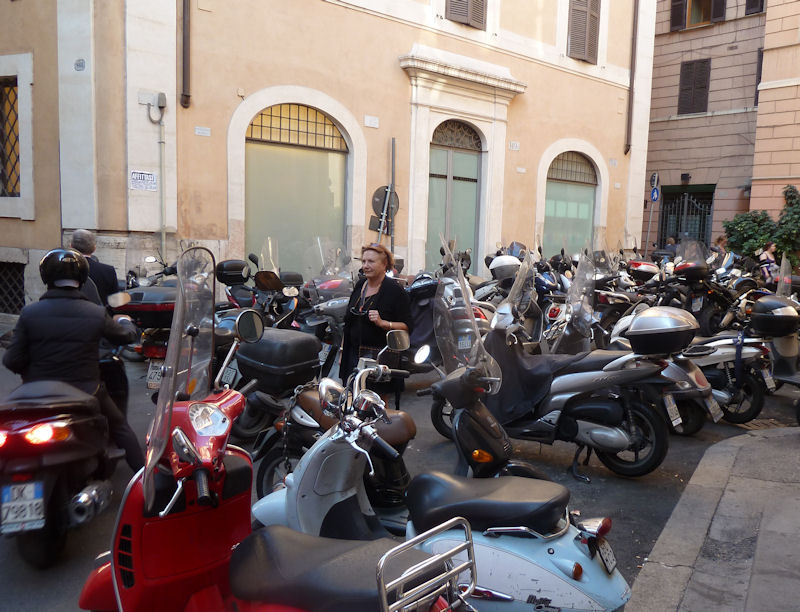
Kristin and motor scooters

Bernini's Four Rivers fountain in the Piazza Navona, the first time I've ever seen it without scaffolding all round it
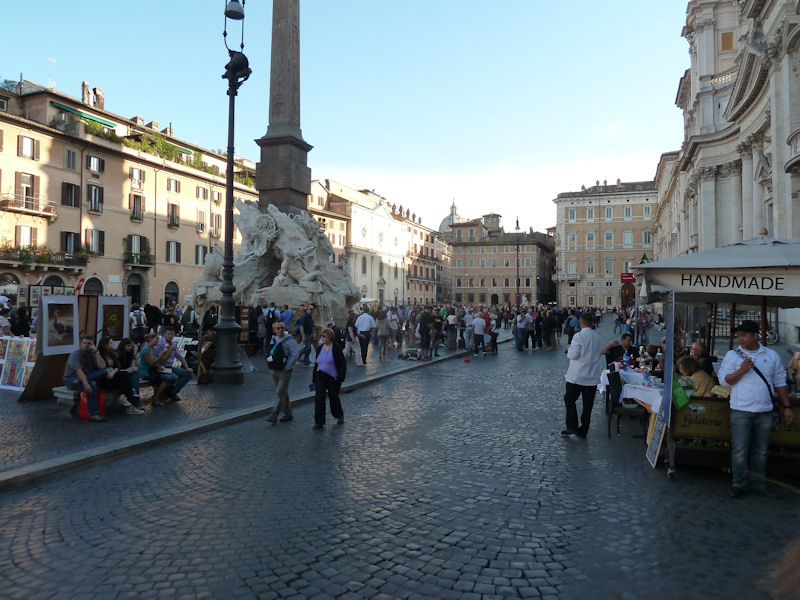
The Piazza Navona, nowadays occupied chiefly by sketch and portait artists who specialize in either Sylvester Stallone or you, as required.
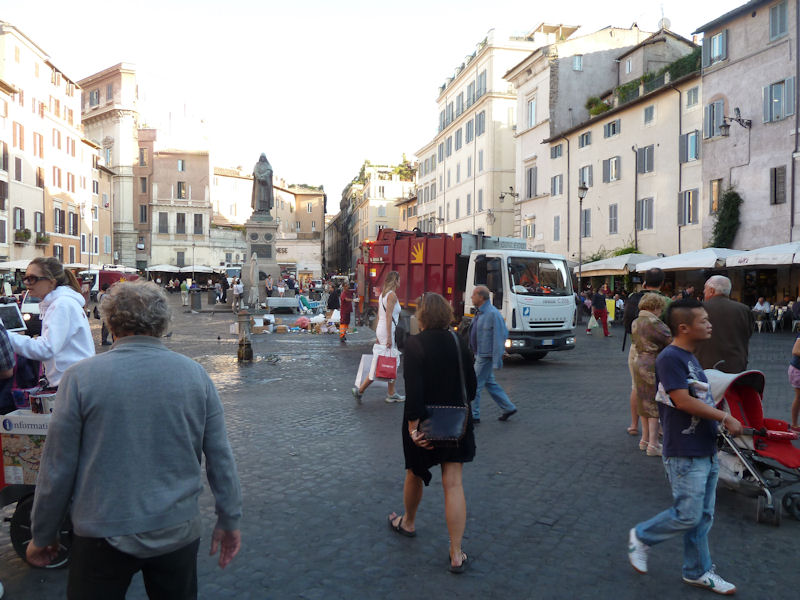
Campo de' Fiore, smelly. The fruit, vegetable, and flower markets have decamped and the city has moved in to muck it all out. That's Giordano Bruno presiding over it all.
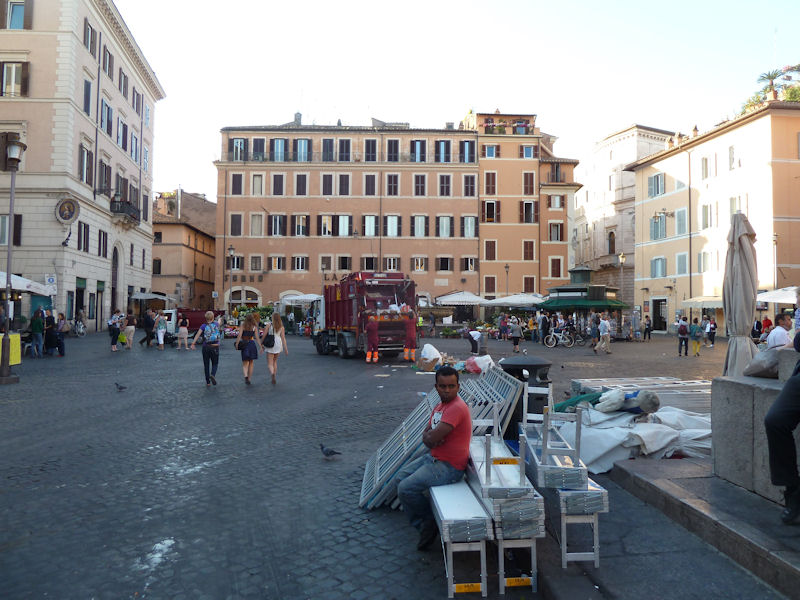
The brilliant philosopher-plus Giordano Bruno was burnt at the stake here in 1600. I spent years trying to identify the spy codenamed "Fagot" in the French embassy in London in 1583-85 and I concluded that it could not be done, and in 1991 John Bossy identified "Fagot" as Giordano Bruno (Giordano Bruno and the Embassy Affair, 1991). So I missed that one, too.
[But in Under the molehill: an Elizabethan spy story, 2001, Prof Bossy sort of changed his mind about that.]
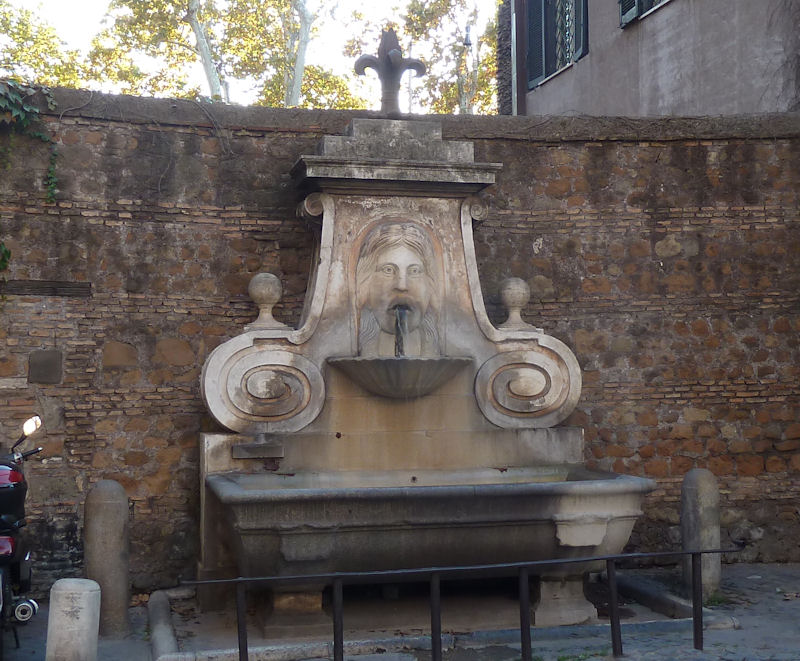
Oh no, please. . . .
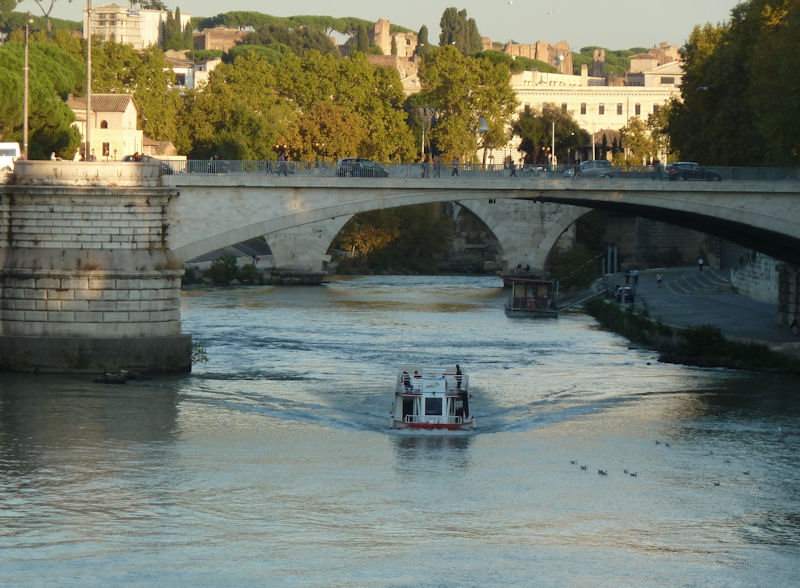
The Bridge on the Tiber. That's it for this trip -- Joellen and Richard are off to the boat docks for their cruise to the Caribbean and we're headed back home.
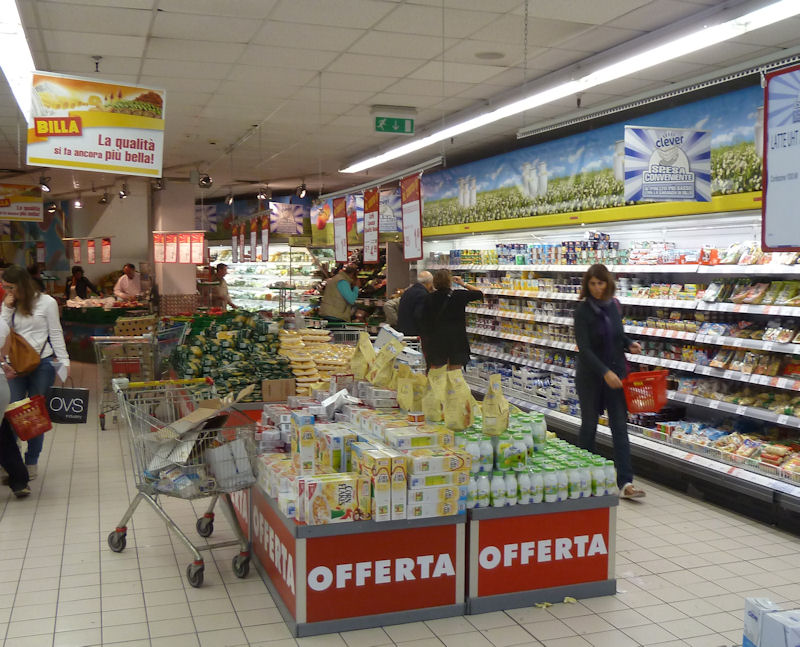
But we are NOT going home without a carry-on bag full of Italian groceries.
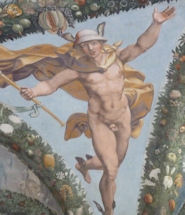 Dwight Peck's personal website
Dwight Peck's personal website





















































































